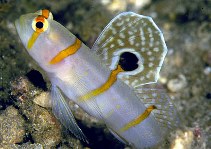| Family: |
Gobiidae (Gobies), subfamily: Gobiinae |
| Max. size: |
12 cm SL (male/unsexed) |
| Environment: |
reef-associated; marine |
| Distribution: |
Western Pacific: Moluccas to the Solomon Islands, north to Ryukyu Islands, south to the northern Great Barrier Reef; Palau in Micronesia. |
| Diagnosis: |
Dorsal spines (total): 7-7; Dorsal soft rays (total): 12-12; Anal spines: 1-1; Anal soft rays: 12-12. Characterized by white body color; head and body with seven narrow orange bars; first dorsal fin with prominent pale-edged black spot and numerous smaller white spots; tall and fan-like first dorsal fin; separate pelvic fins, joined only by low membrane at base of fins; without median predorsal scales; cycloid scales embedded extending forward on side of nape slightly anterior to upper end of operculum; longitudinal scale series 54-63; greatest depth of body 4.9-5.7 in SL; caudal fin usually longer than head (Ref. 90102). |
| Biology: |
Occurs on patches of carbonate sand of clear water reefs (Ref. 9710). Usually in rubble caves Lives with an olivaceus prawn with short white transverse marks (Ref. 48637). |
| IUCN Red List Status: |
Least Concern (LC); Date assessed: 26 August 2020 Ref. (130435)
|
| Threat to humans: |
harmless |
Source and more info: www.fishbase.org. For personal, classroom, and other internal use only. Not for publication.
